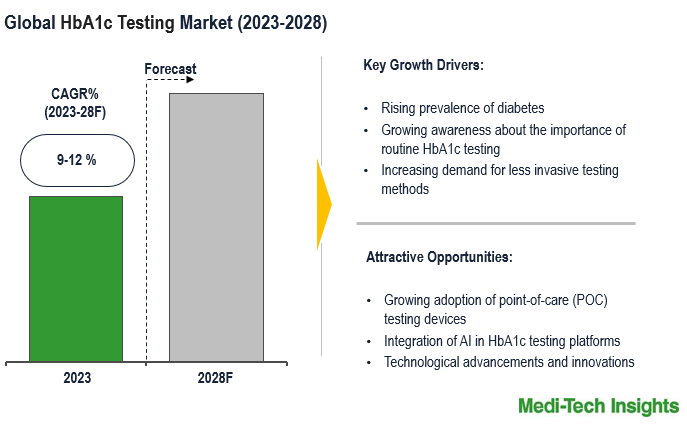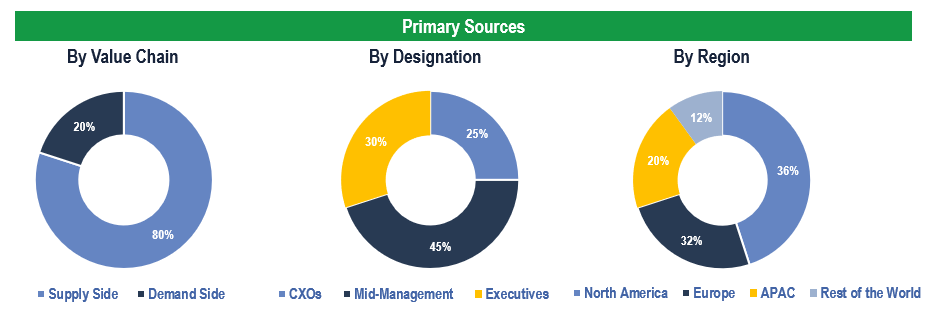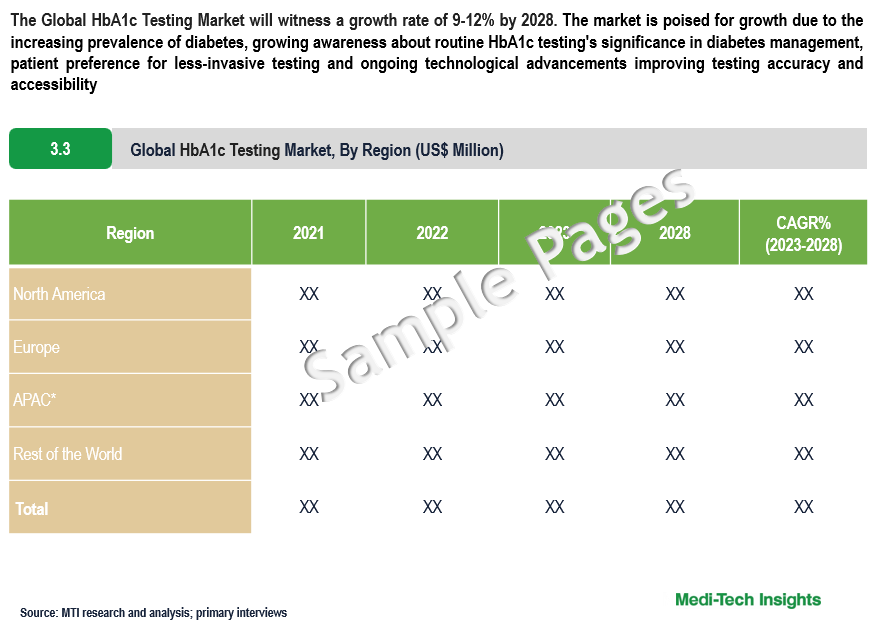Global HbA1c Testing Market Size, Share, Industry Growth Analysis, and Forecast to 2028
The Global HbA1c Testing Market will witness a growth rate of 9-12% by 2028. The market is poised for growth due to the increasing prevalence of diabetes, growing awareness about routine HbA1c testing’s significance in diabetes management, patient preference for less-invasive testing and ongoing technological advancements improving testing accuracy and accessibility. To learn more about the research report, download a sample report.
HbA1c testing, also known as glycated haemoglobin testing, is a crucial diagnostic tool in diabetes management, particularly for type 2 diabetes. This test measures the average blood sugar level over the past 2 to 3 months by assessing the glucose attached to haemoglobin in red blood cells, offering valuable insights into long-term blood sugar control. Healthcare providers use the results to adjust treatment plans, monitor disease management, and assess the risk of complications such as cardiovascular disease and nerve damage. Regular HbA1c testing is recommended for individuals with diabetes to ensure optimal disease management and minimize long-term health risks. In diabetes, inadequate insulin production or utilization leads to elevated blood sugar levels. The A1C test measures the percentage of red blood cells with glucose-coated haemoglobin, providing a three-month average due to the lifespan of red blood cells. Elevated A1C levels indicate high blood glucose associated with diabetes, which, if uncontrolled, can lead to serious health complications.
Key Factors Driving Growth in HbA1c Testing for Diabetes Control
Hemoglobin A1c (HbA1c) testing is a pivotal tool in the monitoring and treatment of diabetes, playing a significant role in disease management. The field's growth is fueled by several key factors and advancements in this domain encompassing the rising prevalence of diabetes, growing awareness regarding the necessity of routine HbA1c assessment for effective diabetes control, and the continuous evolution of technology, which enhances the precision, efficiency, and accessibility of HbA1c testing methodologies. For instance,
- In May 2019, Siemens Healthineers announced the global availability of the new Atellica CH Enzymatic Hemoglobin A1c (A1c_E) Assay, designed to aid clinicians in diagnosing and monitoring diabetes, providing accurate and precise results by integrating onto chemistry testing platforms
The widespread adoption of point-of-care testing (POCT) devices further emphasizes the importance of timely HbA1c measurements across various healthcare settings. These advancements are supported by initiatives focused on early diabetes detection, patient preferences for less invasive testing options, regulatory mandates emphasizing HbA1c testing's significance, and the seamless integration of testing into electronic health records (EHR) systems for optimized patient care. Collectively, these factors signify a dynamic shift towards a more comprehensive and patient-centric approach to managing diabetes.

To learn more about this report, download the PDF brochure
Innovations in HbA1c Testing: A Pathway to Improved Diabetes Outcomes
There has been a notable shift towards the adoption of continuous glucose monitoring (CGM) systems, which offer real-time glucose monitoring, thereby complementing the traditional HbA1c testing method. Additionally, there is a growing trend in the adoption of portable and smartphone-connected HbA1c testing devices, enabling at-home monitoring and facilitating telemedicine practices. Furthermore, there have been significant developments in HbA1c assays, focusing on enhancing accuracy, sensitivity, and specificity to improve diabetes management. Personalized medicine approaches are gaining prominence, tailoring diabetes management strategies based on individual HbA1c levels and other patient-specific factors. For instance,
- In June 2023, Abbott announced that its FreeStyle Libre 2 system became the first and only continuous glucose monitoring system to receive nationwide reimbursement in France for individuals on once-daily basal insulin, thereby expanding access to CGM systems and benefiting a larger diabetic population; France leads in Europe with this reimbursement, following similar expansions in Japan and the U.S. (Medicare)
Recent developments in this field include introducing HbA1c testing kits with faster turnaround times and reduced sample volume requirements, facilitating more efficient testing processes. Moreover, the integration of artificial intelligence (AI) algorithms into HbA1c testing platforms allows for advanced data analysis and interpretation, aiding in better decision-making for healthcare professionals. There is ongoing research and development towards non-invasive or minimally invasive HbA1c testing methods, such as saliva or breath-based assays, aiming to improve patient comfort and convenience. Another advancement is the launch of HbA1c testing solutions with enhanced connectivity features, enabling seamless data transfer and remote monitoring, aligning with the broader trend of digital health integration. These advancements collectively signify a progressive landscape in HbA1c testing technology, aiming to improve patient outcomes and enhance the quality of care provided to individuals with diabetes.
HbA1c Testing Market: Key Constraints/Challenges
Challenges in the HbA1c testing market include complex regulatory approval processes due to varying regional requirements, necessitating continuous investment in research and development for technological advancements. High device costs alongside limited reimbursement policies can hinder the demand for the HbA1c testing market. Moreover, a lack of awareness about HbA1c testing, especially in developing countries, and interference from haemoglobin variants pose additional challenges for manufacturers, necessitating solutions to ensure reliable results.
North America Accounts for the Largest Share of the Global Market
Regional analysis of the HbA1c testing market provides valuable insights into the variations and dynamics across different geographical areas. In North America, the market is driven by factors such as the high prevalence of diabetes, advanced healthcare infrastructure, and the presence of key market players. Additionally, increasing awareness about diabetes management and technological advancements contribute to market growth in this region. In Europe, stringent regulatory frameworks and government initiatives promoting diabetes care and prevention play a significant role in shaping the HbA1c testing market. Moreover, the rising adoption of point-of-care testing devices and increasing healthcare expenditure contribute to market expansion. The Asia Pacific region is witnessing rapid market growth due to the escalating prevalence of diabetes, particularly in countries like China and India. Additionally, increasing healthcare investments, improving healthcare infrastructure, and rising awareness about the importance of regular HbA1c testing are driving market growth in this region.
HbA1c Testing Market: Competitive Landscape
Some of the key players operating in the market are Abbott Laboratories, Bio-Rad Laboratories, Inc., ARKRAY, Inc., Danaher, F. Hoffmann-La Roche Ltd, Siemens Healthineers, TransAsia Bio-Medicals, Trinity Biotech, EKF Diagnostics, Beckman Coulter, Inc., and Randox Laboratories Ltd. among others.

Get a Sample Report for Competitive Landscape Analysis
Organic and Inorganic Growth Strategies Adopted by Players to Establish Their Foothold in the Market
Players operating in this market are adopting both organic and inorganic growth strategies such as collaborations, and acquisitions to garner market share. For instance,
- In September 2023, Abbott finalized its acquisition of Bigfoot Biomedical, aiming to bolster its footprint in diabetes care. This acquisition complements Abbott's existing FreeStyle Libre® continuous glucose monitoring technology, aligning with the company's mission to innovate personalized and precise solutions for diabetes management.
- In December 2021, ARKRAY commenced full-scale operations at six newly established locations in Europe, including five sales offices in Italy, Spain, Portugal, the United Kingdom, and Belgium, along with a manufacturing base in Ireland.
The HbA1c testing market is expected to gain further momentum in the coming years due to the increasing prevalence of diabetes, growing demand for less-invasive techniques & personalized medicine, technological advancements, and aggressive organic and inorganic growth strategies followed by the players.
Key Strategic Questions Addressed
- What is the market size & forecast for the Global HbA1c Testing Market?
- What are the historical, present, and forecasted market shares and growth rates of various segments and sub-segments of the Global HbA1c Testing Market?
- How has COVID-19 impacted the Global HbA1c Testing Market?
- What are the major growth drivers, restraints/challenges impacting the market?
- What are the opportunities prevailing in the market?
- What is the investment landscape?
- Which region has the highest share in the global market? Which region is expected to witness the highest growth rate in the next 5 years?
- Who are the major players operating in the market? What is the competitive positioning of key players?
- Who are the new players entering the market?
- What are the key strategies adopted by players?
- Research Methodology
- Secondary Research
- Primary Research
- Market Estimation
- Market Forecasting
- Executive Summary
- Market Overview
- Market Dynamics
- Drivers
- Restraints
- Opportunities
- Market Dynamics
- Global HbA1c Testing Market - Size & Forecast (2021-2028), By Product Type
- Instruments
- Reagents
- Kits
- Other Product Types
- Global HbA1c Testing Market - Size & Forecast (2021-2028), By Technology
- Ion-exchange HPLC
- Enzymatic assay
- Affinity binding chromatography
- Others
- Global HbA1c Testing Market - Size & Forecast (2021-2028), By End User
- Hospitals
- Clinics
- Diagnostic Centers
- Academic and Research Institutes
- Other End Users
- Global HbA1c Testing Market - Size & Forecast (2021-2028), By Region
- North America (U.S. & Canada)
- Europe (UK, Germany, France, Italy, Spain, Rest of Europe)
- Asia Pacific (China, India, Japan, Rest of Asia Pacific)
- Rest of the World (Latin America, Middle East & Africa)
- Competitive Landscape
- Key Players and their Competitive Positioning
- Competitive Positioning of Key Players (2022)
- Offerings Assessment, By Players
- Key Strategies Assessment, By Player (2021-2023)
- New Product Launches
- Partnerships, Agreements, & Collaborations
- Mergers & Acquisitions
- Other Developments
- Key Players and their Competitive Positioning
- Key Companies Scanned (Indicative List)
- Abbott Laboratories
- Bio-Rad Laboratories, Inc.
- ARKRAY, Inc.
- Danaher Corporation
- Hoffmann-La Roche Ltd
- Siemens Healthineers
- TransAsia Bio-Medicals
- Trinity Biotech,
- EKF Diagnostics
- Beckman Coulter, Inc.
- Randox Laboratories Ltd.
- Other Players
The study has been compiled based on extensive primary and secondary research.
Secondary Research (Indicative List)

Primary Research
To validate research findings (market size & forecasts, market segmentation, market dynamics, competitive landscape, key industry trends, etc.), extensive primary interviews were conducted with both supply and demand-side stakeholders.
Supply Side Stakeholders:
- Senior Management Level: CEOs, Presidents, Vice-Presidents, Directors, Chief Technology Officers, Chief Commercial Officers
- Mid-Management Level: Product Managers, Sales Managers, Brand Managers, Business Development Managers, Consultants
Demand Side Stakeholders:
- Stakeholders in Hospitals, Clinics, Diagnostic Centers and Academic & Research Institutes among others
Breakdown of Primary Interviews

Market Size Estimation
Both ‘Top-Down and Bottom-Up Approaches’ were used to derive market size estimates and forecasts.
Data Triangulation
Research findings derived through secondary sources & internal analysis were validated with Primary Interviews, Internal Knowledge Repository, and Company Sales Data.



